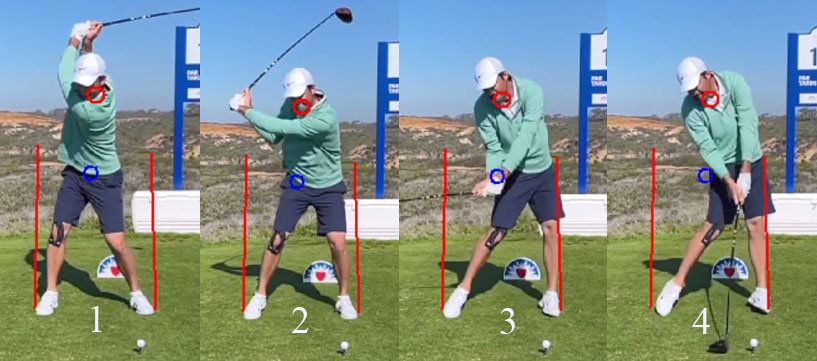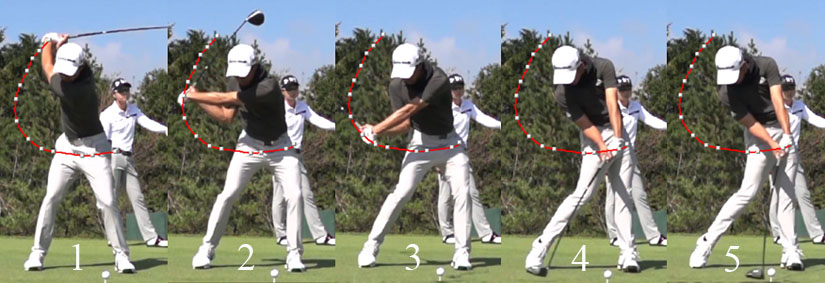Post by imperfectgolfer on Mar 29, 2023 10:11:47 GMT -5
Part 1-:
In this post I am going to summarise my present-day opinions regarding the utility of Swing Catalyst GRF measurements.
I am not a golf instructor, who teaches student-golfers using technological devices like the Swing Catalyst device or a Hack Motion device. I am only an amateur golf theorist who tries to better understand the golf swing biomechanics/mechanics performed by pro golfers. Even though I have no practical experience using a Swing Catalyst device, I am mentally capable of analysing the data obtained from a Swing Catalyst device and I am also mentally capable of analysing whether the acquired ground reaction force (GRF) data can be useful from a golf instructional perspective. In another thread, Jim George suggested that my personal opinions have no merit because I have no practical experience using a Swing Catalyst device, but I strongly believe that my personal opinions have merit if I thoroughly evaluate the "evidence" provided by golf instructors who do use a Swing Catalyst device.
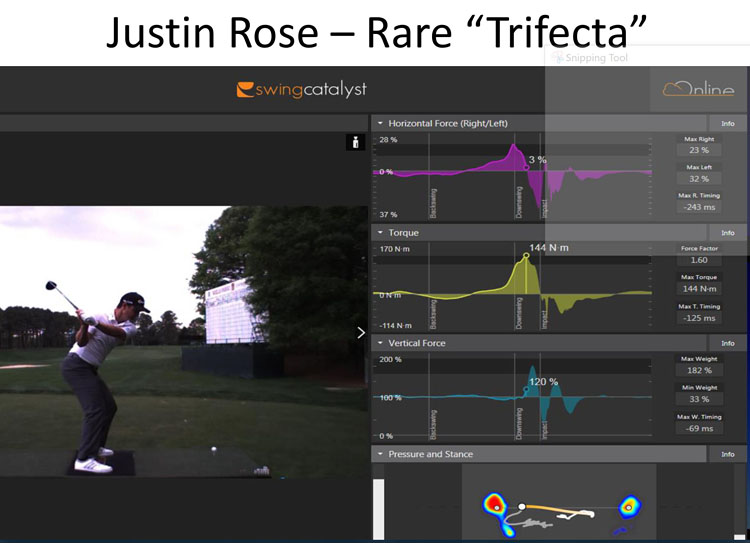

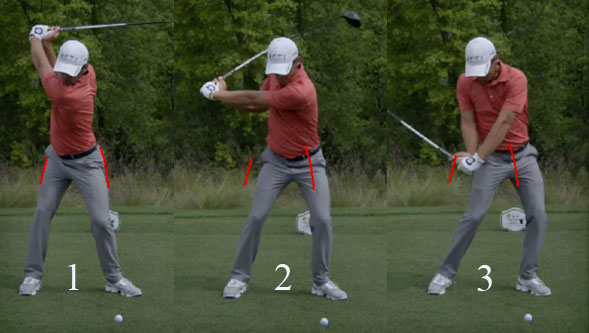


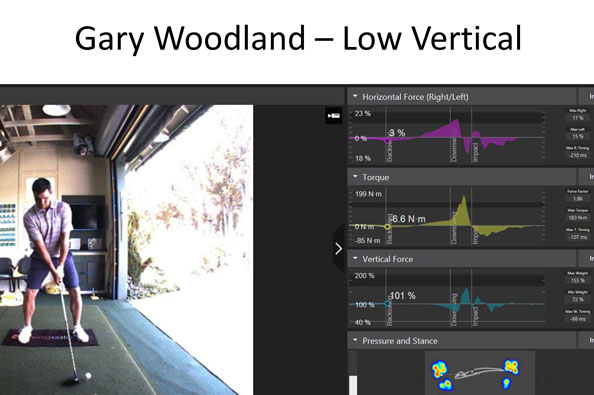



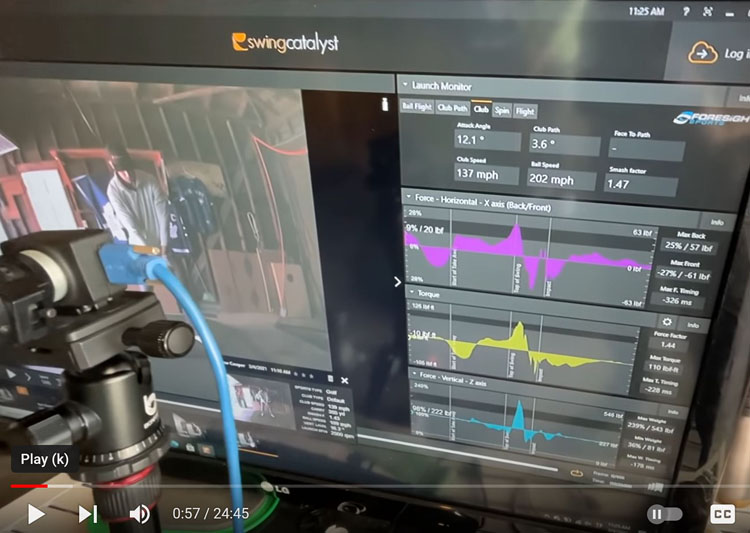

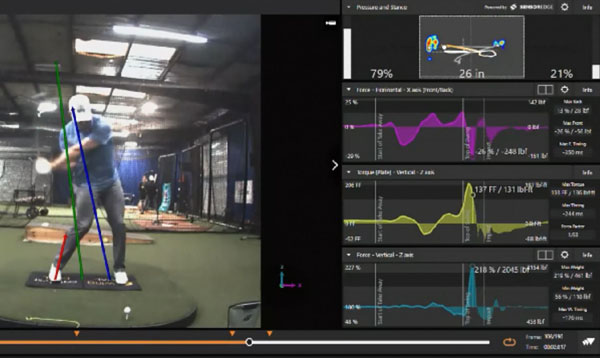
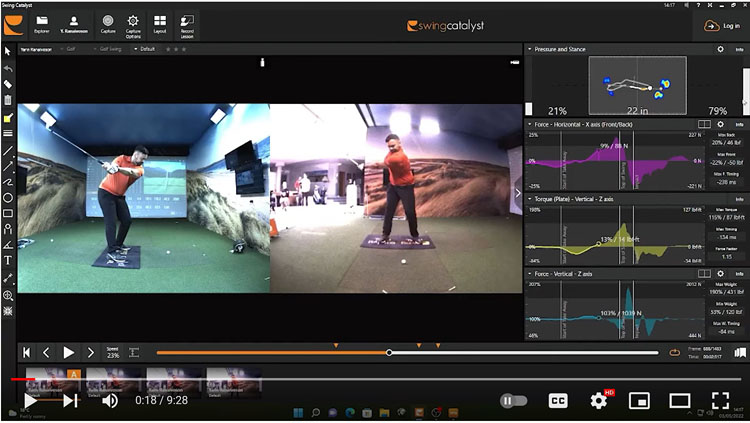

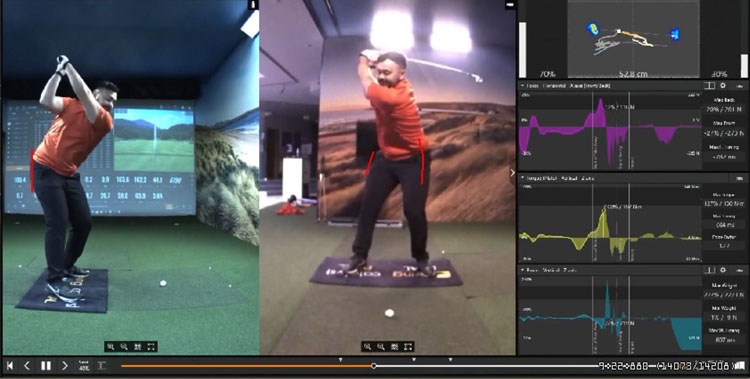
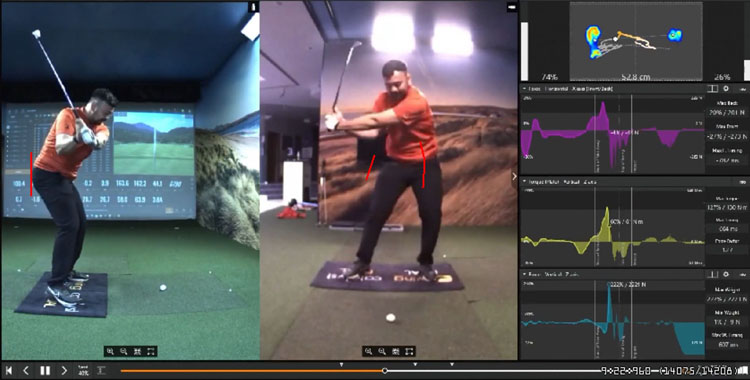

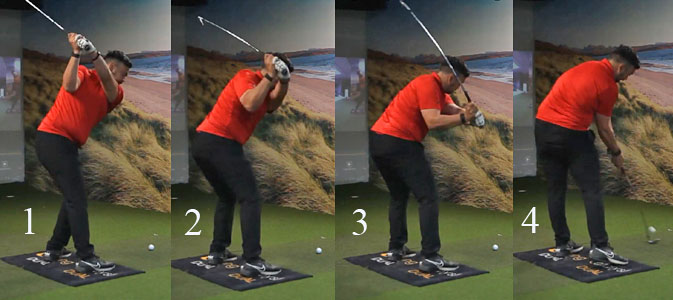
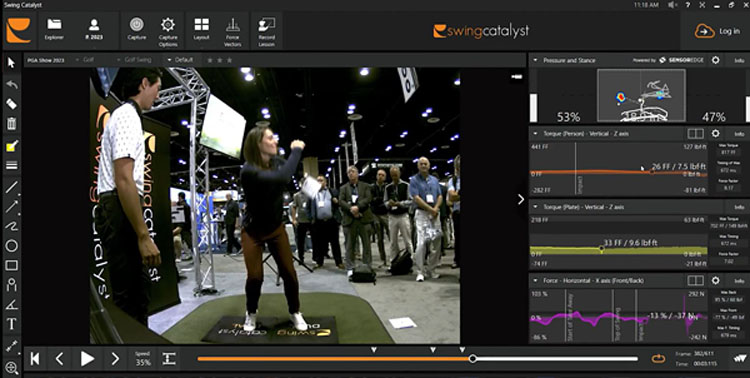
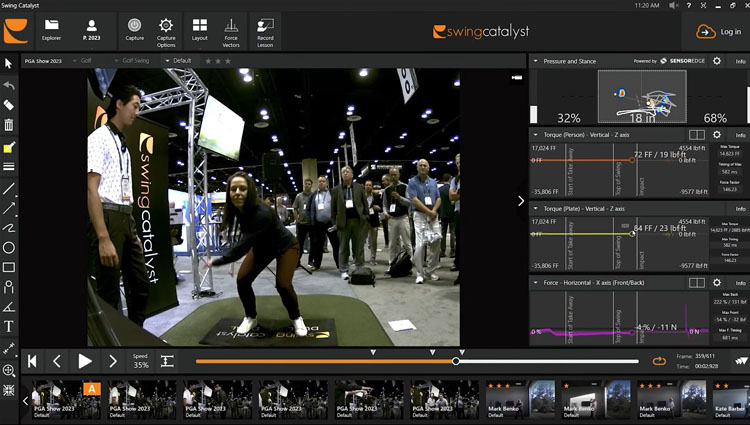
In this post I am going to summarise my present-day opinions regarding the utility of Swing Catalyst GRF measurements.
I am not a golf instructor, who teaches student-golfers using technological devices like the Swing Catalyst device or a Hack Motion device. I am only an amateur golf theorist who tries to better understand the golf swing biomechanics/mechanics performed by pro golfers. Even though I have no practical experience using a Swing Catalyst device, I am mentally capable of analysing the data obtained from a Swing Catalyst device and I am also mentally capable of analysing whether the acquired ground reaction force (GRF) data can be useful from a golf instructional perspective. In another thread, Jim George suggested that my personal opinions have no merit because I have no practical experience using a Swing Catalyst device, but I strongly believe that my personal opinions have merit if I thoroughly evaluate the "evidence" provided by golf instructors who do use a Swing Catalyst device.
This post will only be understandable if a reader has sufficient background knowledge of what measurements are being made by a Swing Catalyst device, and uninformed readers should at least view this video presentation by Scott Lynn if they do not have the requisite background knowledge.
Here is what an "average" pro quality SC trace would look like - featuring Justin Rose's SC measurements.

The magenta-colored graph is a measure of his horizontal GRF and it usually peaks first at P3.5 - P4.5. The positive horizontal GRF measurement is usually due to pushing off the trail foot in a targetwards direction and the negative measurement is due to the golfer pushing off his lead foot in an away-from-the-target direction.
The yellow-colored graph is a measure of his rotary torque GRF and it usually peaks slightly later between P4.5 - P5.
The cyan-colored graph is a measure of his vertical GRF graph and it usually peaks between P5 - P5.5. Note that there is a very good correlation between the timing of the peak of the vertical GRF and the peak of the negative horizontal GRF, which makes sense from a biomechanical perspective. A golfer can use the negative horizontal GRF to "brake" the targetwards motion of the pelvis so that he can avoid excessive pelvic sway in the targetwards direction and it also allows him to more efficiently direct the lead side of the pelvis to move backwards away from the ball-target line (in the direction of the tush line) when the lead leg straightens between P5.5 => P7.
The black strip zone in the background represents the PGA tour averages and JR reaches into that zone with respect to all of his GRFs and he represents what Scott Lynn calls a "Trifecta".
I do not dispute that this "Trifecta" pattern is often seen in skilled amateur and pro golfers, and I only dispute that it is a necessary requirement for performing a pro-quality driver golf swing action. I fully agree that a golfer has to generate GRFs when performing a full golf swing action and it is impossible to perform a full golf swing action in an efficient manner when standing on an ice rink. However, I question whether there is any direct correlation between a "Trifecta" pattern of GRFs and a good quality golf swing action as judged from the perspective of a golfer's overall golf swing biomechanics and, most importantly, in terms of a golfer's ability to consistently hit the ball straight towards his intended target. I do not dispute an opinion that optimising the GRFs forces so as to better mimic the "Trifecta" pattern can potentially increase the maximum clubhead speed measured at impact in a driver swing by approximately 5 - 10mph in a subset of skilled golfers - but that does not mean that their golf swing's biomechanical motions are optimum.
Here are a few examples of pro golfers who do not manifest the "Trifecta" pattern, but who can still drive the ball a long distance (~300 yards) when playing on the PGA tour.
Here is Charles Howell III's SC measurements - measured when his rotary torque GRF peaks at P5.
The yellow-colored graph is a measure of his rotary torque GRF and it usually peaks slightly later between P4.5 - P5.
The cyan-colored graph is a measure of his vertical GRF graph and it usually peaks between P5 - P5.5. Note that there is a very good correlation between the timing of the peak of the vertical GRF and the peak of the negative horizontal GRF, which makes sense from a biomechanical perspective. A golfer can use the negative horizontal GRF to "brake" the targetwards motion of the pelvis so that he can avoid excessive pelvic sway in the targetwards direction and it also allows him to more efficiently direct the lead side of the pelvis to move backwards away from the ball-target line (in the direction of the tush line) when the lead leg straightens between P5.5 => P7.
The black strip zone in the background represents the PGA tour averages and JR reaches into that zone with respect to all of his GRFs and he represents what Scott Lynn calls a "Trifecta".
I do not dispute that this "Trifecta" pattern is often seen in skilled amateur and pro golfers, and I only dispute that it is a necessary requirement for performing a pro-quality driver golf swing action. I fully agree that a golfer has to generate GRFs when performing a full golf swing action and it is impossible to perform a full golf swing action in an efficient manner when standing on an ice rink. However, I question whether there is any direct correlation between a "Trifecta" pattern of GRFs and a good quality golf swing action as judged from the perspective of a golfer's overall golf swing biomechanics and, most importantly, in terms of a golfer's ability to consistently hit the ball straight towards his intended target. I do not dispute an opinion that optimising the GRFs forces so as to better mimic the "Trifecta" pattern can potentially increase the maximum clubhead speed measured at impact in a driver swing by approximately 5 - 10mph in a subset of skilled golfers - but that does not mean that their golf swing's biomechanical motions are optimum.
Here are a few examples of pro golfers who do not manifest the "Trifecta" pattern, but who can still drive the ball a long distance (~300 yards) when playing on the PGA tour.
Here is Charles Howell III's SC measurements - measured when his rotary torque GRF peaks at P5.

Note that CH III has the typical pattern of GRF generation where the horizontal GRF peaks first, followed by the sequential peaking of the rotary torque GRF and then the vertical GRF.
However, note that the magnitude of his rotary torque GRF is very small and yet he is fully capable of driving the golf ball >300 yards.
Here are capture images of his downswing action.
However, note that the magnitude of his rotary torque GRF is very small and yet he is fully capable of driving the golf ball >300 yards.
Here are capture images of his downswing action.

Image 1 is at P4, image 2 is at P5 and image 3 is at P5.5.
Note that CH III manifests a rightwards pelvic loading pattern and a borderline rightwards/vertical centralised upper torso loading pattern by P4. Note that I have drawn red lines alongside the outer border of his pelvis at his P4 position.
Note that CH III manifests a lot of pelvic shift motion in a targetwards direction between P4 => P5.5 and it is therefore understandable why he generates a large magnitude horizontal GRF at the start of his transition to the downswing in order to efficiently perform that pattern of pelvic shift motion. It is also understandable why he needs to generate a large vertical GRF peaking at ~P5.5 in order to allow him to generate a large negative horizontal GRF that is needed to "brake" the targetswards motion of his pelvis.
However, he obviously does not need to generate a large rotary torque GRF (peaking at ~P5) in order to perform a good rotary motion of his pelvis and upper torso during his downswing action. This SC measurement was made many years ago and his coach (Dana Dahlquist) has apparently worked with CH III in order to change his SC measurement pattern. I have not seen his latest SC measurements to determine whether he is generating a larger rotary torque GRF and I also have no evidence that he is driving the ball further and straighter as a result of any changes in his SC measurement pattern. If you have any "evidence", then I would be very interested in analysing that "evidence".
Here is Boo Weekley's SC measurements.
Note that CH III manifests a rightwards pelvic loading pattern and a borderline rightwards/vertical centralised upper torso loading pattern by P4. Note that I have drawn red lines alongside the outer border of his pelvis at his P4 position.
Note that CH III manifests a lot of pelvic shift motion in a targetwards direction between P4 => P5.5 and it is therefore understandable why he generates a large magnitude horizontal GRF at the start of his transition to the downswing in order to efficiently perform that pattern of pelvic shift motion. It is also understandable why he needs to generate a large vertical GRF peaking at ~P5.5 in order to allow him to generate a large negative horizontal GRF that is needed to "brake" the targetswards motion of his pelvis.
However, he obviously does not need to generate a large rotary torque GRF (peaking at ~P5) in order to perform a good rotary motion of his pelvis and upper torso during his downswing action. This SC measurement was made many years ago and his coach (Dana Dahlquist) has apparently worked with CH III in order to change his SC measurement pattern. I have not seen his latest SC measurements to determine whether he is generating a larger rotary torque GRF and I also have no evidence that he is driving the ball further and straighter as a result of any changes in his SC measurement pattern. If you have any "evidence", then I would be very interested in analysing that "evidence".
Here is Boo Weekley's SC measurements.

Note that BW generates a very small horizontal GRF and a very small vertical GRF in his driver golf swing action, and yet he can drive the golf ball ~280 - 290 yards.
Here are capture images of his driver's downswing action.
Here are capture images of his driver's downswing action.

Image 1 is at P4, image 2 is at P5, image 3 is at P6 and image 4 is at P7.5.
Note that BW uses a centralised pelvic loading pattern and a borderline rightwards-centralised upper torso loading pattern.
Note that BW squares his pelvis between P4 => P5 without swaying his pelvis targetwards and that makes it understandable why he is using a large amount of rotary torque GRF with very little preliminary horizontal GRF between P4 => P5. Also, note that his rotary torque graph starts increasing before his horizontal GRF graph.
Note that BW stalls the rotary motion of his pelvis at ~P5.5 and he does not actively continue to rotate his pelvis between P5.5 => P7.5. Therefore, it is possible that he does not need to generate any significant amount of vertical GRF to move his lead buttock back away from the ball-target line, and also away from the target, between P5.5 => P7. There is also no visual evidence that he is a "jumper " (who uses a launcher pattern requiring a large vertical GRF) through impact and both of his feet seem to be solidly grounded through impact. Even if one does not like his golf swing's torso motional pattern, it seemingly works very well for him and I would like to see any person explain why BW would perform his golf swing action better by significantly increasing either his horizontal GRF between P4 => P4.5 or his vertical GRF between P5 => P6.
Here is Gary Woodland's SC measurements.
Note that BW uses a centralised pelvic loading pattern and a borderline rightwards-centralised upper torso loading pattern.
Note that BW squares his pelvis between P4 => P5 without swaying his pelvis targetwards and that makes it understandable why he is using a large amount of rotary torque GRF with very little preliminary horizontal GRF between P4 => P5. Also, note that his rotary torque graph starts increasing before his horizontal GRF graph.
Note that BW stalls the rotary motion of his pelvis at ~P5.5 and he does not actively continue to rotate his pelvis between P5.5 => P7.5. Therefore, it is possible that he does not need to generate any significant amount of vertical GRF to move his lead buttock back away from the ball-target line, and also away from the target, between P5.5 => P7. There is also no visual evidence that he is a "jumper " (who uses a launcher pattern requiring a large vertical GRF) through impact and both of his feet seem to be solidly grounded through impact. Even if one does not like his golf swing's torso motional pattern, it seemingly works very well for him and I would like to see any person explain why BW would perform his golf swing action better by significantly increasing either his horizontal GRF between P4 => P4.5 or his vertical GRF between P5 => P6.
Here is Gary Woodland's SC measurements.

Note that GW manifests the standard kinetic sequence of GRFs where the horizontal GRF peaks first, followed by the peaking of the rotary torque GRF, and then followed by the peaking of the vertical GRF.
However, note that GW generates a very small magnitude of vertical GRF and yet he is still one of the longest drivers on the PGA tour. I know of no reason to believe that GW would benefit by increasing the magnitude of his vertical GRF so that it reaches PGA tour levels (black zone) and I can identify no flaws in his driver golf swing torso's motion that are reflective of a deficit in the magnitude of his vertical GRF generation. If any person has an alternative opinion, feel free to express that opinion in a post.
Here is Matt Kuchar's SC measurements.
However, note that GW generates a very small magnitude of vertical GRF and yet he is still one of the longest drivers on the PGA tour. I know of no reason to believe that GW would benefit by increasing the magnitude of his vertical GRF so that it reaches PGA tour levels (black zone) and I can identify no flaws in his driver golf swing torso's motion that are reflective of a deficit in the magnitude of his vertical GRF generation. If any person has an alternative opinion, feel free to express that opinion in a post.
Here is Matt Kuchar's SC measurements.

According to Scott Lynn, MK is the only pro golfer he has seen who has a disordered kinetic GRF sequence where the rotary torque GRF peaks before the horizontal GRF. Also, note the small magnitude of the vertical GRF graph. I am not personally surprised to note these GRF measurements because MK is a prototypical example of a Jim Hardy one-plane swing golfer.
After seeing these SC measurements, a golf instructor (? Mike Adams or Terry Rowles) worked with MK to improve his GRF measurements and obtained the following results.
After seeing these SC measurements, a golf instructor (? Mike Adams or Terry Rowles) worked with MK to improve his GRF measurements and obtained the following results.

Note that these SC graphs show the standard kinetic GRF sequence where the horizontal GRF peaks before the rotary torque GRF.
Do these changes represent an improvement? According to Mike Adams they do because MK's clubhead speed at impact went up by ? 5 - 10 mph.
However, when using this "altered" golf swing GRF-pattern MK started to hit too many balls left in his golf practice sessions so he stopped using that pattern, and he went back to his original GRF-pattern. This example demonstrates the weakness of the Mike Adams golf instructional approach (based on SC measurements) where he focuses his primary attention on maximising clubhead speed. I have viewed a number of videos where Mike Adams marginally increased a golfer's maximum clubhead speed at impact by 5 - 10mph, but I saw nothing to suggest that it improved the golfer's overall golf swing biomechanics in such a manner that it would improve his ability to consistently hit the ball straighter.
Consider an example how a golf instructor could use SC measurements to alter a golfer's golf swing action.
Watch the following video between the 56:40 - 1:06:31 minute time points.
Do these changes represent an improvement? According to Mike Adams they do because MK's clubhead speed at impact went up by ? 5 - 10 mph.
However, when using this "altered" golf swing GRF-pattern MK started to hit too many balls left in his golf practice sessions so he stopped using that pattern, and he went back to his original GRF-pattern. This example demonstrates the weakness of the Mike Adams golf instructional approach (based on SC measurements) where he focuses his primary attention on maximising clubhead speed. I have viewed a number of videos where Mike Adams marginally increased a golfer's maximum clubhead speed at impact by 5 - 10mph, but I saw nothing to suggest that it improved the golfer's overall golf swing biomechanics in such a manner that it would improve his ability to consistently hit the ball straighter.
Consider an example how a golf instructor could use SC measurements to alter a golfer's golf swing action.
Watch the following video between the 56:40 - 1:06:31 minute time points.
SL is working with an amateur golfer, who he calls "Harrison".
Here is Harrison's SC measurements when using a 7-iron.
Here is Harrison's SC measurements when using a 7-iron.

Note that he has the standard GRF kinetic pattern.
Scott Lynn noted that his clubhead path was too much in-to-out (6.9 degrees) at impact. He also stated that Harrison's rotary torque GRF measurement was below the tour average while his horizontal GRF was in the tour zone. SL then hypothesised that too much horizontal GRF combined with too little rotary torque GRF is causally responsible for Harrison's excessively in-to-out clubhead path. I can partly understand the logic of SL's reasoning considering the height of this golfer and how narrow his stance is in the face of too much horizontal GRF generation, and I can easily imagine this golfer being susceptible to too much pelvic sway motion at the start of his downswing that can predispose to an excessive in-to-out clubhead path pre-impact. Interestingly, SL did not demonstrate that this golfer has too much left-lateral pelvic sway motion during the early-mid downswing and he did nothing to get this golfer to decrease his horizontal GRF generation. Instead, SL decided to work on increasing Harrison's rotary torque GRF. SL first got the golfer to swing using the "one-leg swing test" to determine which is his dominant (stronger) leg. I personally think that the test is irrational if a golfer uses a TGM swinging action where low point is located below the lead shoulder socket - because it is much easier to swing better off the lead leg than the trail leg when performing a TGM swinging action. Also, this one-leg technique encourages an artificial upper body-powered golf swing action, which is not what many skilled golfers would normally use in their "real life" golf swing action. SL decided, based on the one-leg swing test, that Harrison's lead leg is his dominant leg and he therefore decided to work on his lead leg's ability to generate a horizontal GRF. SL used the training drill technique, which he calls reactive neuromuscular training, where the golf instructor uses an elasticised rubber band - see the 1:01:25 - 1:02:25 minute time point of the video. The purpose of the drill is to get the golfer to push against the ground with his lead foot in a "towards the ball-target line" direction, which theoretically should cause the lead pelvis to move back towards the tush line. After performing the drill, there was negligible improvement in his excessive in-to-out clubhead path swing fault (which was 5.9 degrees at the end of the drill training session) and an insignificant change in his clubhead speed (which was not really a problem that even needed to be addressed because he was generating an excellent clubhead speed of 93 mph with a 7-iron).
Here is another video where Scott Lynn measures the GRFs of the amateur long-hitter - Drew Cooper - and then attempts to modify his GRF pattern with the goal of increasing his driver clubhead speed at impact.
Scott Lynn noted that his clubhead path was too much in-to-out (6.9 degrees) at impact. He also stated that Harrison's rotary torque GRF measurement was below the tour average while his horizontal GRF was in the tour zone. SL then hypothesised that too much horizontal GRF combined with too little rotary torque GRF is causally responsible for Harrison's excessively in-to-out clubhead path. I can partly understand the logic of SL's reasoning considering the height of this golfer and how narrow his stance is in the face of too much horizontal GRF generation, and I can easily imagine this golfer being susceptible to too much pelvic sway motion at the start of his downswing that can predispose to an excessive in-to-out clubhead path pre-impact. Interestingly, SL did not demonstrate that this golfer has too much left-lateral pelvic sway motion during the early-mid downswing and he did nothing to get this golfer to decrease his horizontal GRF generation. Instead, SL decided to work on increasing Harrison's rotary torque GRF. SL first got the golfer to swing using the "one-leg swing test" to determine which is his dominant (stronger) leg. I personally think that the test is irrational if a golfer uses a TGM swinging action where low point is located below the lead shoulder socket - because it is much easier to swing better off the lead leg than the trail leg when performing a TGM swinging action. Also, this one-leg technique encourages an artificial upper body-powered golf swing action, which is not what many skilled golfers would normally use in their "real life" golf swing action. SL decided, based on the one-leg swing test, that Harrison's lead leg is his dominant leg and he therefore decided to work on his lead leg's ability to generate a horizontal GRF. SL used the training drill technique, which he calls reactive neuromuscular training, where the golf instructor uses an elasticised rubber band - see the 1:01:25 - 1:02:25 minute time point of the video. The purpose of the drill is to get the golfer to push against the ground with his lead foot in a "towards the ball-target line" direction, which theoretically should cause the lead pelvis to move back towards the tush line. After performing the drill, there was negligible improvement in his excessive in-to-out clubhead path swing fault (which was 5.9 degrees at the end of the drill training session) and an insignificant change in his clubhead speed (which was not really a problem that even needed to be addressed because he was generating an excellent clubhead speed of 93 mph with a 7-iron).
Here is another video where Scott Lynn measures the GRFs of the amateur long-hitter - Drew Cooper - and then attempts to modify his GRF pattern with the goal of increasing his driver clubhead speed at impact.
Here is a capture image of Drew's Swing Catalyst measurements.

Note that Drew can achieve GRFs that exceed the black zone (tour average zone) with respect to all of those GRFs and that his vertical GRF is 239% of his body weight.
Drew wants to increase his clubhead speed at impact from 140mph to a larger value.
Even though he already has a very high vertical GRF, Scott suggests that he try to increase his vertical GRF, which peaks in his early downswing. However, that idea does not work-out to be beneficial because it causes Drew to *"feel" that his upper body is "falling back" (away from the target) which causes Drew's clubhead speed to then decrease. Drew mentions that he wants to stay centered during his downswing action and avoid any "hanging-back" phenomenon involving his upper torso. Scott then suggests that he needs to strengthen the abdominal muscles on the left side of his abdomen so that he can increase his vertical GRF even more without having to experience a "falling back" phenomenon of his upper torso. Scott believes that if Drew can increase his vertical GRF more while avoiding any tendency for his upper torso to "fall-back", that the increased vertical GRF would translate into a faster clubhead speed at impact. Why should it? How can an increased vertical GRF measurement at ~P5.5 increase clubhead speed?
(* To understand why increasing the vertical GRF under the lead foot in the early downswing can theoretically cause the upper body to be predisposed to rotate counterclockwise around the body's COM, watch the following AMG video - www.youtube.com/watch?v=e82g4YuXv1Y&t=566s - between the 13:20 - 15:20 minute time points).
Here are capture images of Drew's downswing action.
Drew wants to increase his clubhead speed at impact from 140mph to a larger value.
Even though he already has a very high vertical GRF, Scott suggests that he try to increase his vertical GRF, which peaks in his early downswing. However, that idea does not work-out to be beneficial because it causes Drew to *"feel" that his upper body is "falling back" (away from the target) which causes Drew's clubhead speed to then decrease. Drew mentions that he wants to stay centered during his downswing action and avoid any "hanging-back" phenomenon involving his upper torso. Scott then suggests that he needs to strengthen the abdominal muscles on the left side of his abdomen so that he can increase his vertical GRF even more without having to experience a "falling back" phenomenon of his upper torso. Scott believes that if Drew can increase his vertical GRF more while avoiding any tendency for his upper torso to "fall-back", that the increased vertical GRF would translate into a faster clubhead speed at impact. Why should it? How can an increased vertical GRF measurement at ~P5.5 increase clubhead speed?
(* To understand why increasing the vertical GRF under the lead foot in the early downswing can theoretically cause the upper body to be predisposed to rotate counterclockwise around the body's COM, watch the following AMG video - www.youtube.com/watch?v=e82g4YuXv1Y&t=566s - between the 13:20 - 15:20 minute time points).
Here are capture images of Drew's downswing action.

Image 1 is at P4, image 2 is at P4.5, image 3 is at P5, image 4 is at P5.5, image 5 is at impact and image 6 is at P7.4.
Note that I have drawn blue lines alongside his head and red lines alongside the outer border of his pelvis at his P4 position.
Note that Drew has a centralised pelvic loading pattern and a borderline rightwards-centralised upper torso loading pattern during his backswing action that ends at P4.
Note that Drew starts his downswing with a re-centering phenomenon where his upper and lower swing centers slide targetwards between P4 => P5 while he is simultaneously squatting and performing a hip-squaring action where he rotates his pelvis counterclockwise to become square by P5.
Note that Drew has achieved his peak vertical GRF by P5.5 (image 4) and that is also when his lead arm speed has probably reached its maximum speed due to his pivot-induced release of PA#4. Note that he has successfully "braked" his lead pelvis's targetwards slide by P5.5 and he is successfully avoiding any "fall-back" of his upper body. So, how could increasing his vertical GRF at P5.5 increase his clubhead speed? I can see no deficit in his golf swing biomechanics that would cause him to release PA#4 with sub-maximum efficiency between P4 => P5.5 and to cause him to release PA#2 with sub-maximum efficiency between P5.5 => P7. Note how efficiently he elevates his lead shoulder socket between P5 => P7 due to a very well-executed lead leg straightening action, which is simultaneously combined with a stretching-out phenomenon of the left side of his mid-upper torso, so he is presumably maximising the centripetal component of his MoF torque that is causally responsible for providing the torque-force needed to efficiently release PA#2.
Scott's suggestion that Drew needs to strengthen his left-sided abdominal wall muscles makes no sense to me. I can see no evidence of Drew's upper torso falling back during the swing power phase causing the release of PA#4 between P4 => P5.5. Also, Scott's claim that an increasing vertical GRF will invariably cause a counterclockwise rotation of the upper torso (in an away from the target direction) because the vertical GRF vector is closer to the target than the body's COM is not necessarily applicable to Drew's driver golf swing action - although it may be applicable to the driver golf swing action of many pro golfers.
Here is a capture image showing Drew's vertical GRF vector/magnitude when he is at his ~P5.4 position when his vertical GRF has reached its peak value.
Note that I have drawn blue lines alongside his head and red lines alongside the outer border of his pelvis at his P4 position.
Note that Drew has a centralised pelvic loading pattern and a borderline rightwards-centralised upper torso loading pattern during his backswing action that ends at P4.
Note that Drew starts his downswing with a re-centering phenomenon where his upper and lower swing centers slide targetwards between P4 => P5 while he is simultaneously squatting and performing a hip-squaring action where he rotates his pelvis counterclockwise to become square by P5.
Note that Drew has achieved his peak vertical GRF by P5.5 (image 4) and that is also when his lead arm speed has probably reached its maximum speed due to his pivot-induced release of PA#4. Note that he has successfully "braked" his lead pelvis's targetwards slide by P5.5 and he is successfully avoiding any "fall-back" of his upper body. So, how could increasing his vertical GRF at P5.5 increase his clubhead speed? I can see no deficit in his golf swing biomechanics that would cause him to release PA#4 with sub-maximum efficiency between P4 => P5.5 and to cause him to release PA#2 with sub-maximum efficiency between P5.5 => P7. Note how efficiently he elevates his lead shoulder socket between P5 => P7 due to a very well-executed lead leg straightening action, which is simultaneously combined with a stretching-out phenomenon of the left side of his mid-upper torso, so he is presumably maximising the centripetal component of his MoF torque that is causally responsible for providing the torque-force needed to efficiently release PA#2.
Scott's suggestion that Drew needs to strengthen his left-sided abdominal wall muscles makes no sense to me. I can see no evidence of Drew's upper torso falling back during the swing power phase causing the release of PA#4 between P4 => P5.5. Also, Scott's claim that an increasing vertical GRF will invariably cause a counterclockwise rotation of the upper torso (in an away from the target direction) because the vertical GRF vector is closer to the target than the body's COM is not necessarily applicable to Drew's driver golf swing action - although it may be applicable to the driver golf swing action of many pro golfers.
Here is a capture image showing Drew's vertical GRF vector/magnitude when he is at his ~P5.4 position when his vertical GRF has reached its peak value.

Note that his lead foot's resultant GRF (blue arrow) is large and mainly responsible for the magnitude of his overall GRF (green arrow). Note that both of those GRF arrow vectors are angled away from the target and they are both behind his body's COM, which has shifted a lot targetwards between P4 => P5.5 due to his re-centering phenomenon. That means that his upper torso is theoretically being subjected to a clockwise rotation around his imaginary COM, which should actually prevent a "falling-back" phenomenon of his upper torso. Therefore, Scott's theory about the relationship between the vertical GRF and a "falling-back" phenomenon of the upper torso may not be valid with respect to Drew's driver golf swing action.
I personally think that Scott's "theories" about the effect of a large vertical GRF on Drew's golf swing biomechanics and its effect on Drew's ability to increase his clubhead speed at impact has no merit - because I think that there is no direct causal connection between the vertical GRF that is measured at the level where the feet interact with the ground and the efficiency of a golfer's golf swing biomechanics that is causally responsible for causing the release of PA#4 => PA#2 with maximum efficiency.
I will now present another very dramatic example of Scott Lynn teaching a golfer that I think clearly shows the futility of only focusing on GRF measurements to improve a golfer's golf swing action.
I personally think that Scott's "theories" about the effect of a large vertical GRF on Drew's golf swing biomechanics and its effect on Drew's ability to increase his clubhead speed at impact has no merit - because I think that there is no direct causal connection between the vertical GRF that is measured at the level where the feet interact with the ground and the efficiency of a golfer's golf swing biomechanics that is causally responsible for causing the release of PA#4 => PA#2 with maximum efficiency.
I will now present another very dramatic example of Scott Lynn teaching a golfer that I think clearly shows the futility of only focusing on GRF measurements to improve a golfer's golf swing action.
This video was made at a level 2 workshop in Luxembourg where Scott Lynn is teaching a student golfer (Yann) using a Swing Catalyst device.
Here is Yann's Swing Catalyst measurements at the start of teaching session when he was swinging a mid-iron at a clubhead speed of 96mph at impact.
Here is Yann's Swing Catalyst measurements at the start of teaching session when he was swinging a mid-iron at a clubhead speed of 96mph at impact.

Note that he has a good kinetic GRF sequence where the horizontal GRF peaks first, followed by peaking of the rotary torque GRF and then followed finally by the peaking of the vertical GRF. Note that he generates a very high horizontal GRF and vertical GRF that is well within the tour average range even though he is only swinging an iron and not a driver. Note that his rotary torque measurement is just below the tour average range. He is very close to manifesting a perfect "Trifecta" pattern - as defined by Scott Lynn.
Scott Lynn (SL) starts off his presentation between the 0:00 - 1:02 minute time point of the video by asking a fundamental question - based on Yann's SC-measurements should one make him a rear post golfer who will then need to create more horizontal GRF in order to swing faster, or should he get Yann to become a front post golfer who will then need to increase his vertical GRF in order to swing faster, or should he make Yann a center post golfer who will then need to increase his rotary GRF in order to swing faster.
SL then decides to use two tests to determine Yann's leg dominance pattern. The first test is the one-leg swing test (which I have previously mentioned) and which happens between the 1:20 - 2:00 minute time points of the video. Watch Yann swing and you will note that he is actually using an active upper body rotary motion to power his golf swing action, and he is not really using his pelvis/legs to power his golf swing. So, how one can reasonably think that this single-leg swinging test can possibly determine whether one will perform a better golf swing action as a rear post, center post or front post golfer? SL concludes, based on that swing test, that Yann's test results are intermediate between a front post and a center post golfer.
SL then gets Yann to perform another test to determine leg dominance - watch the video between the 3:08 - 3:48 minute time points of the video. That's a strange test that only tests whether a golfer can maintain his balance when rotating 90 degrees by leaning to one side or the other side, and I cannot fathom how it can determine whether a golfer will perform a full golf swing action more efficiently as a rear post, center post or front post golfer.
SL concludes, based on Yann's leg dominance testing performance, that Yann should use a center post technique and that he should increase his rotary torque GRF by performing SL's reactive neuromuscular training drills - see the 6:08 - 8:08 minute time point of the video. Note that the supposedly true purpose of the training drill is to get Yann to rotate his pelvis better during the downswing so that his pelvis can be more open at impact. Interestingly, SL makes a comment during the drill where he states that Yann's chest is rotating better! That is a very important point - because if you look carefully at Yann's performance during the drill, one can see that he is actively rotating his upper torso when the true purpose of the drill is to get the lead leg to push more forcefully away from the ball-target line in the direction of the tush line in order to actively improve one's counterclockwise pelvic rotation between P5 => P7.
After performing the reactive neuromuscular training drill session, Yann performs his golf swing action and SL is happy with the results because Yann has decreased his horizontal GRF to a small degree, but he has significantly increased his rotary torque GRF measurement. Most importantly, note that SL does not mention whether Yann's increased rotary torque GRF measurement translates to a better pelvic rotation where he can reach impact with a more open pelvic alignment (eg. 45 degrees open at impact).
So, let's look more closely at Yann's golf swing action that was recorded at the end of the video.
Scott Lynn (SL) starts off his presentation between the 0:00 - 1:02 minute time point of the video by asking a fundamental question - based on Yann's SC-measurements should one make him a rear post golfer who will then need to create more horizontal GRF in order to swing faster, or should he get Yann to become a front post golfer who will then need to increase his vertical GRF in order to swing faster, or should he make Yann a center post golfer who will then need to increase his rotary GRF in order to swing faster.
SL then decides to use two tests to determine Yann's leg dominance pattern. The first test is the one-leg swing test (which I have previously mentioned) and which happens between the 1:20 - 2:00 minute time points of the video. Watch Yann swing and you will note that he is actually using an active upper body rotary motion to power his golf swing action, and he is not really using his pelvis/legs to power his golf swing. So, how one can reasonably think that this single-leg swinging test can possibly determine whether one will perform a better golf swing action as a rear post, center post or front post golfer? SL concludes, based on that swing test, that Yann's test results are intermediate between a front post and a center post golfer.
SL then gets Yann to perform another test to determine leg dominance - watch the video between the 3:08 - 3:48 minute time points of the video. That's a strange test that only tests whether a golfer can maintain his balance when rotating 90 degrees by leaning to one side or the other side, and I cannot fathom how it can determine whether a golfer will perform a full golf swing action more efficiently as a rear post, center post or front post golfer.
SL concludes, based on Yann's leg dominance testing performance, that Yann should use a center post technique and that he should increase his rotary torque GRF by performing SL's reactive neuromuscular training drills - see the 6:08 - 8:08 minute time point of the video. Note that the supposedly true purpose of the training drill is to get Yann to rotate his pelvis better during the downswing so that his pelvis can be more open at impact. Interestingly, SL makes a comment during the drill where he states that Yann's chest is rotating better! That is a very important point - because if you look carefully at Yann's performance during the drill, one can see that he is actively rotating his upper torso when the true purpose of the drill is to get the lead leg to push more forcefully away from the ball-target line in the direction of the tush line in order to actively improve one's counterclockwise pelvic rotation between P5 => P7.
After performing the reactive neuromuscular training drill session, Yann performs his golf swing action and SL is happy with the results because Yann has decreased his horizontal GRF to a small degree, but he has significantly increased his rotary torque GRF measurement. Most importantly, note that SL does not mention whether Yann's increased rotary torque GRF measurement translates to a better pelvic rotation where he can reach impact with a more open pelvic alignment (eg. 45 degrees open at impact).
So, let's look more closely at Yann's golf swing action that was recorded at the end of the video.

This capture image shows Yann at his P4 position where his horizontal GRF is at its peak value (which is still very high and near the top of the tour average range).
Note that Yann is using an arch-extension maneuver to arch his upper thoracic spine more towards the target - based on SL's advice. Why SL would recommend an arch-extension maneuver for a center-post golfer is inexplicable from my perspective!
Note that I have drawn red lines along the back of his trail buttock (and that represents the tush line) and also alongside the outer border of his pelvis.
Note that Yann is using an arch-extension maneuver to arch his upper thoracic spine more towards the target - based on SL's advice. Why SL would recommend an arch-extension maneuver for a center-post golfer is inexplicable from my perspective!
Note that I have drawn red lines along the back of his trail buttock (and that represents the tush line) and also alongside the outer border of his pelvis.

This capture image is when Yann's rotary torque GRF measurement reaches its peak value and it is just below the black zone (tour average zone).
Note that Yann's rotary torque force peaks before one sees any significant amount of pelvic rotation - and that is fully expected because force should theoretically always precede motion. However, note that he is actively rotating his upper torso counterclockwise, which can be causally responsible for increasing the rotary torque GRF measurement (as described later).
Note that Yann's rotary torque force peaks before one sees any significant amount of pelvic rotation - and that is fully expected because force should theoretically always precede motion. However, note that he is actively rotating his upper torso counterclockwise, which can be causally responsible for increasing the rotary torque GRF measurement (as described later).

This capture image is when Yann's vertical GRF reaches its peak value - which is early, happening at the P5 position.
Note that Yann has successfully completed his hip-squaring action by P5 (as seen on the DTL view). However, look at his face-on view capture image which shows how much he has swayed his pelvis targetwards by P5 where the outer border of his pelvis is outside a vertical line drawn upwards from the outer border of his left foot. He is supposed to be a center post golfer who should manifest the "Sam Snead sit-down look" at P5 - where the pelvis remains centered between the two feet and where there is symmetrical dual external rotation of both femurs in their respective hip joints. Instead, he manifests far too much left-lateral pelvic sway motion - despite the fact that he is generating a very large vertical GRF and simultaneously generating a very large negative horizontal GRF (large horizontal braking force) at P5.
Also, note how steeply his clubshaft is coming down the swingplane with no clubshaft shallowing action.
Note that Yann has successfully completed his hip-squaring action by P5 (as seen on the DTL view). However, look at his face-on view capture image which shows how much he has swayed his pelvis targetwards by P5 where the outer border of his pelvis is outside a vertical line drawn upwards from the outer border of his left foot. He is supposed to be a center post golfer who should manifest the "Sam Snead sit-down look" at P5 - where the pelvis remains centered between the two feet and where there is symmetrical dual external rotation of both femurs in their respective hip joints. Instead, he manifests far too much left-lateral pelvic sway motion - despite the fact that he is generating a very large vertical GRF and simultaneously generating a very large negative horizontal GRF (large horizontal braking force) at P5.
Also, note how steeply his clubshaft is coming down the swingplane with no clubshaft shallowing action.

This capture image is at impact.
Note that he has not rotated his pelvis significantly more counterclockwise in his later downswing between P5 => P7 and his pelvis is only borderline open at impact - despite trying to improve his pelvic rotary torque action by performing SL's reactive neuromuscular training drill. His rotary torque GRF graph has increased slightly and reached the lower limits of the black zone (tour average zone) but it has not translated into a better rotary motion of his pelvis between P5.5 => P7.
Also, note that he has lost his spinal bend inclination angle and that he is "standing-up" through impact with both buttocks moving away from the tush line. I believe that it is due to the combination of too much pelvic slide motion combined with an inadequate amount of pelvic rotary motion.
Note that his upper torso is parallel to the ball-target line, and that it is not open to the ball-target line at impact (as can be seen in his reactive neuromuscular training drill action).
Note that he has a very sub-optimum hand release action through impact where he is stalling the targetwards motion of his lead arm and fully straightening his trail arm and trail wrist in a slap-hinge manner through impact - thereby resulting in a gross example of a flipping sub-type of non-DH hand release action through impact.
Here are capture images of one of his full swings that he performs at the end of the video.
Note that he has not rotated his pelvis significantly more counterclockwise in his later downswing between P5 => P7 and his pelvis is only borderline open at impact - despite trying to improve his pelvic rotary torque action by performing SL's reactive neuromuscular training drill. His rotary torque GRF graph has increased slightly and reached the lower limits of the black zone (tour average zone) but it has not translated into a better rotary motion of his pelvis between P5.5 => P7.
Also, note that he has lost his spinal bend inclination angle and that he is "standing-up" through impact with both buttocks moving away from the tush line. I believe that it is due to the combination of too much pelvic slide motion combined with an inadequate amount of pelvic rotary motion.
Note that his upper torso is parallel to the ball-target line, and that it is not open to the ball-target line at impact (as can be seen in his reactive neuromuscular training drill action).
Note that he has a very sub-optimum hand release action through impact where he is stalling the targetwards motion of his lead arm and fully straightening his trail arm and trail wrist in a slap-hinge manner through impact - thereby resulting in a gross example of a flipping sub-type of non-DH hand release action through impact.
Here are capture images of one of his full swings that he performs at the end of the video.

Image 1 is at P4, image 2 is at P4.5, image 3 is at P5 and image 4 is at impact.
Note that he has completed the hip-squaring action by P5, but his lead hip joint is higher than his trail hip joint as a result of his excessive pelvic slide motion.
Note how steeply his clubshaft comes down the swingplane and there is no clubshaft shallowing action happening between P4 => P6 - which is not surprising considering the fact that he does get any right lateral bend that can drop his trail shoulder lower in a ferris-wheel manner during his later downswing and he also does not perform an active trail upper arm adduction maneuver that is combined with a pitch elbow motion of his trail elbow.
Note that his pelvis is barely open at impact and that his shoulders are square to the ball-target line at impact. Note that he is not moving his lead shoulder up-and-inside/left during his later downswing as a result of a counterclockwise rotation of his pelvis/upper torso and note that he is stalling his lead arm and slapping at the ball with his trail arm/hand at impact.
I personally think that Yann has a very sub-optimum golf swing action despite manifesting an excellent "Trifecta" pattern of GRF generation. This example shows that there is no direct/positive correlation between excellent GRF measurements obtained by a Swing Catalyst device and good quality golf swing biomechanical motions, and I think that by only concentrating on getting Yann to generate a larger rotary torque GRF measurement during his early downswing that SL has done nothing usefully productive to improve Yann's golf swing biomechanical motions.
Finally, here is a very important fact that golf instructors, who use the Swing Catalyst device, do not seemingly even factor-in into the rotary torque GRF-generation equation.
Watch the following Swing Catalyst video.
Note that he has completed the hip-squaring action by P5, but his lead hip joint is higher than his trail hip joint as a result of his excessive pelvic slide motion.
Note how steeply his clubshaft comes down the swingplane and there is no clubshaft shallowing action happening between P4 => P6 - which is not surprising considering the fact that he does get any right lateral bend that can drop his trail shoulder lower in a ferris-wheel manner during his later downswing and he also does not perform an active trail upper arm adduction maneuver that is combined with a pitch elbow motion of his trail elbow.
Note that his pelvis is barely open at impact and that his shoulders are square to the ball-target line at impact. Note that he is not moving his lead shoulder up-and-inside/left during his later downswing as a result of a counterclockwise rotation of his pelvis/upper torso and note that he is stalling his lead arm and slapping at the ball with his trail arm/hand at impact.
I personally think that Yann has a very sub-optimum golf swing action despite manifesting an excellent "Trifecta" pattern of GRF generation. This example shows that there is no direct/positive correlation between excellent GRF measurements obtained by a Swing Catalyst device and good quality golf swing biomechanical motions, and I think that by only concentrating on getting Yann to generate a larger rotary torque GRF measurement during his early downswing that SL has done nothing usefully productive to improve Yann's golf swing biomechanical motions.
Finally, here is a very important fact that golf instructors, who use the Swing Catalyst device, do not seemingly even factor-in into the rotary torque GRF-generation equation.
Watch the following Swing Catalyst video.
Watch the video starting at the 14 minute time point when the Swing Catalyst Ambassador-Presenter starts to talk about the concept of rotary GRF generation. He instructs the volunteer to perform a 360 degrees jump-rotation action and he measures the amount of rotary torque GRF being generated under her feet.
This is the result.
This is the result.

Note that she generates a rotary torque GRF measurement of 33FF/9.6 lbs/foot.
The Swing Catalyst Ambassador-Presenter is obviously not happy with the magnitude of her rotary torque GRF measurement and he instructs her to repeat the 360 degrees jump-rotation action as before, but he instructs her to deliberately spin her shoulders more actively during her 360 degree jump-rotation action by "throwing her arms around" to create more rotary torque.
Here is the result.
The Swing Catalyst Ambassador-Presenter is obviously not happy with the magnitude of her rotary torque GRF measurement and he instructs her to repeat the 360 degrees jump-rotation action as before, but he instructs her to deliberately spin her shoulders more actively during her 360 degree jump-rotation action by "throwing her arms around" to create more rotary torque.
Here is the result.

Note that she generates a rotary torque GRF measurement of 84FF/23 lbs/foot.
That is nearly 3X the amount of rotary torque GRF generation - and it is the direct result of an active upper torso rotary motion.
In other words, a golfer can theoretically generate far more rotary torque GRF in the early downswing if he adds additional rotary force due to an active upper body rotary maneuver. That means that an upper body swinger can potentially generate a much greater magnitude of rotary torque GRF generation between P4 => P5 than a lower body swinger. However, that will likely result in an OTT move and possibly an out-to-in clubhead path through impact if the pelvis is totally static/passive. If the pelvis is partially active in terms of its rotary motion, the simultaneous addition of more active rotary torque derived from an active upper torso rotation can potentially produce an extremely large rotary torque GRF measurement at ~P4.5, which can be well within the black zone (tour average zone), but very little of that rotary torque GRF measurement will be due to an active leg action (where the trail foot pushes away from the ball-target line while the lead foot pushes towards from the ball-target line).
I strongly suspect that Yann is generating most of his rotary torque GRF measurement, which peaks at P4.5, due an active upper torso rotary action and that he is not actively using his legs to generate any rotary torque GRF during his early downswing. That could partly explain why he had such an ineffective pelvic rotary motion during his downswing action that was performed under the golf instructional supervision of Scott Lynn!
That is nearly 3X the amount of rotary torque GRF generation - and it is the direct result of an active upper torso rotary motion.
In other words, a golfer can theoretically generate far more rotary torque GRF in the early downswing if he adds additional rotary force due to an active upper body rotary maneuver. That means that an upper body swinger can potentially generate a much greater magnitude of rotary torque GRF generation between P4 => P5 than a lower body swinger. However, that will likely result in an OTT move and possibly an out-to-in clubhead path through impact if the pelvis is totally static/passive. If the pelvis is partially active in terms of its rotary motion, the simultaneous addition of more active rotary torque derived from an active upper torso rotation can potentially produce an extremely large rotary torque GRF measurement at ~P4.5, which can be well within the black zone (tour average zone), but very little of that rotary torque GRF measurement will be due to an active leg action (where the trail foot pushes away from the ball-target line while the lead foot pushes towards from the ball-target line).
I strongly suspect that Yann is generating most of his rotary torque GRF measurement, which peaks at P4.5, due an active upper torso rotary action and that he is not actively using his legs to generate any rotary torque GRF during his early downswing. That could partly explain why he had such an ineffective pelvic rotary motion during his downswing action that was performed under the golf instructional supervision of Scott Lynn!
Jeff.


